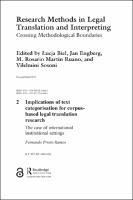Chapter 2 Implications of text categorisation for corpusbased legal translation research
Proposal review
The case of international institutional settings
Abstract
This chapter highlights the relevance of text categorisation for research in legal
translation by focusing on institutional translation settings, namely: the European
Union (EU), the United Nations (UN) and the World Trade Organization
(WTO), and their corresponding adjudicative bodies.1 After briefly reviewing
recurrent issues and models of legal text classification (section 2), a multidimensional
approach is applied to the multilingual text production of the three
representative institutional translation settings during three years over the span
of a decade (2005, 2010 and 2015), as part of the project “Legal Translation
in International Institutional Settings: Scope, Strategies and Quality Markers”
(LETRINT) (section 3). The resulting subdivisions are integrated into a categorisation
matrix and discussed as a way of illustrating the relative nature and implications
of text classifications. The fine-grained description of corpus design and
representativeness, technical aspects of corpus compilation and full taxonomies of
genres are not addressed in this chapter.
Keywords
legal translation; institutional translation settings; EU; UN; WTOISBN
9781351031226OCN
1135847107Publisher
Taylor & FrancisPublisher website
https://taylorandfrancis.com/Publication date and place
2019Imprint
RoutledgeClassification
Language and Linguistics
Law


 Download
Download